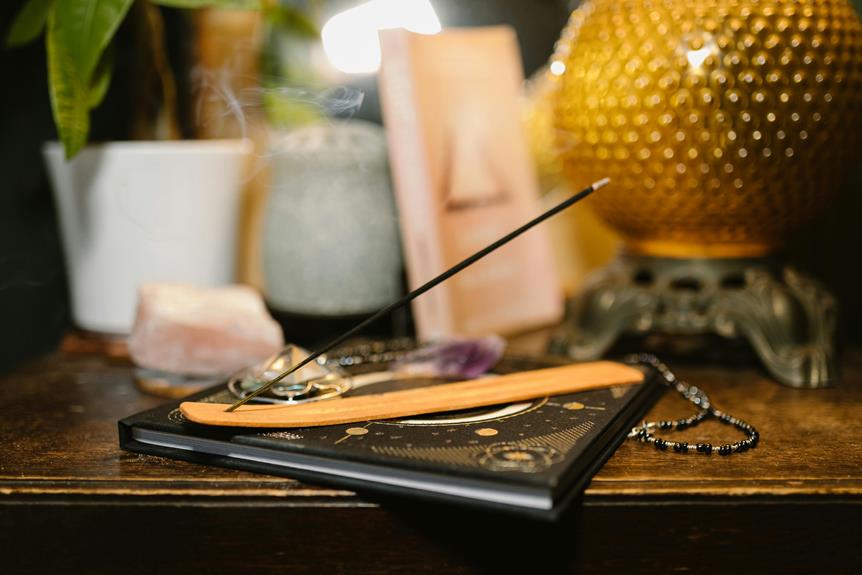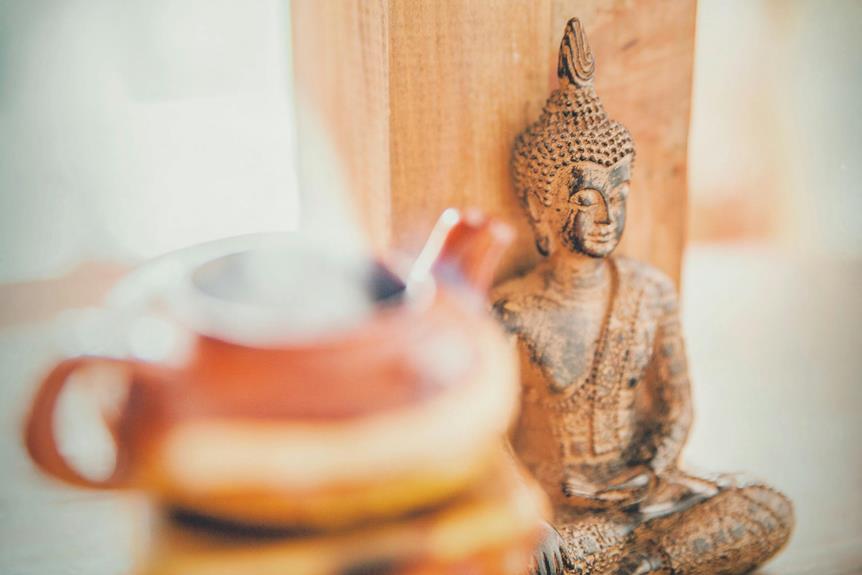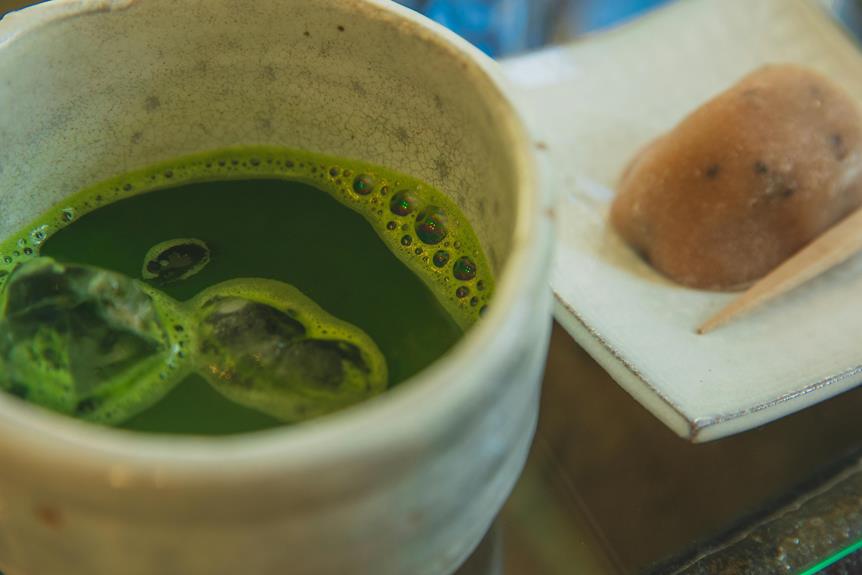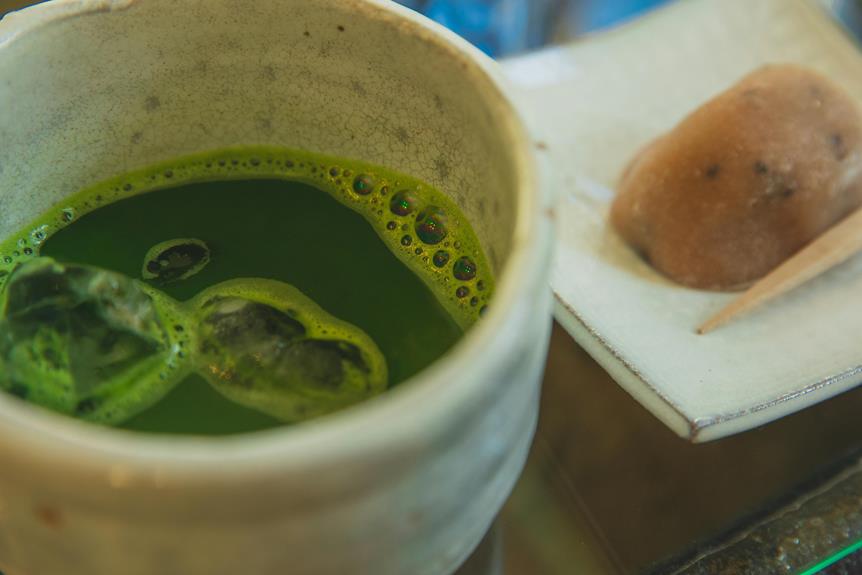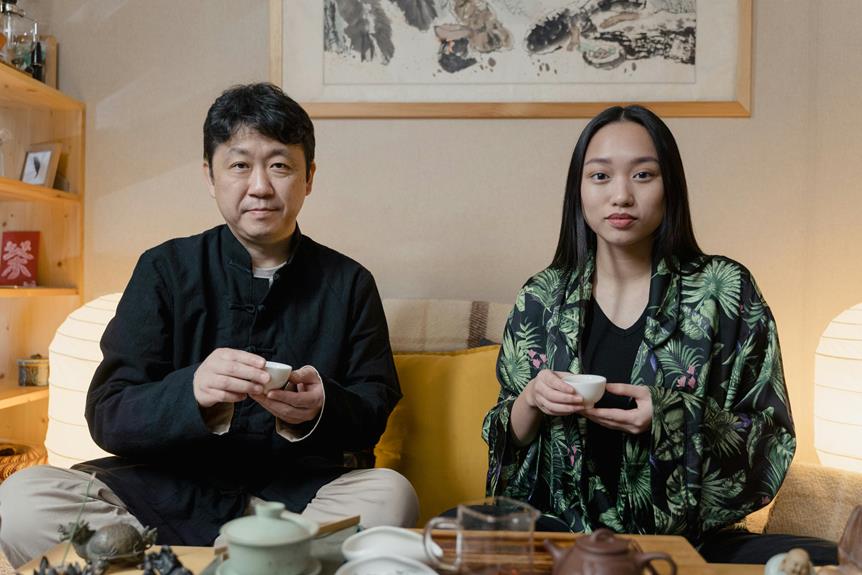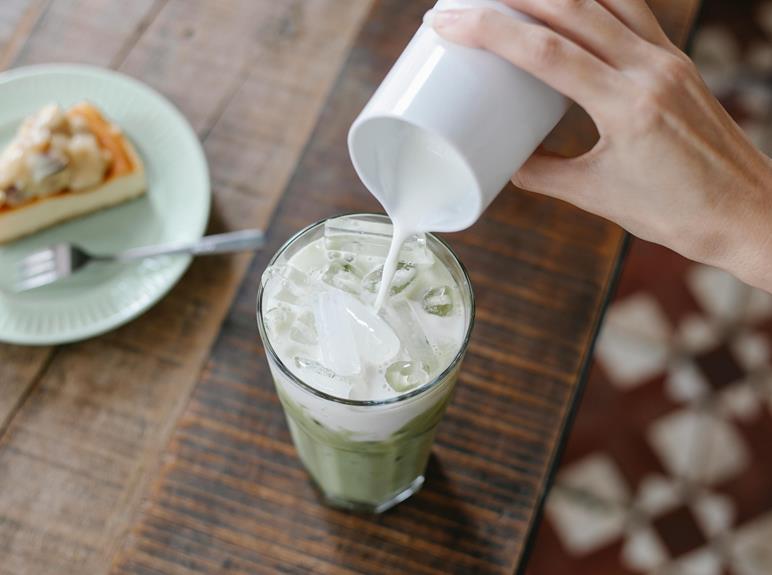As you sit with your cup of tea, you're not just sipping a beverage – you're stepping into a centuries-old tradition of spiritual cultivation, one that awakens your senses, quiets your mind, and aligns you with the present moment. Zen Buddhist monks first used tea to stay focused during meditation, and it's since become an integral part of their rituals. The deliberate process of preparing and drinking tea encourages mindfulness, while the amino acid L-theanine calms the nervous system and quiets racing thoughts. As you slow down and savor each sip, you'll discover how tea can become a meditation in itself, leading you deeper into the simplicity and beauty of the present moment, where new insights and clarity await.
Key Takeaways
- Zen Buddhist monks first discovered tea in China, using it to stay focused and alert during meditation, making it an integral part of their rituals.
- The mindful process of preparing and drinking tea encourages slowing down, focusing on the present moment, and quieting the mind.
- L-theanine, a natural amino acid found in tea, calms the nervous system, reduces stress levels, and promotes a state of calm focus.
- Mindful tea ceremonies create an atmosphere that fosters inner peace, connection with oneself, and cultivates presence, enhancing the meditation experience.
- The deliberate preparation and consumption of tea cultivates clarity, refining awareness, and letting go of mental clutter, embracing simplicity and calm.
The Origins of Tea in Zen
Steeping in the misty mountains of China, Zen Buddhist monks first discovered the energizing properties of tea, which soon became an integral part of their meditation rituals.
You might be surprised to learn that tea played a significant role in the spiritual practices of these monks. As they ventured deeper into their meditation, they found that tea helped them stay focused and alert, allowing them to reach a higher state of consciousness.
The practice soon spread to Tibetan Monasteries, where monks would gather to share a cup of tea before undertaking their meditation sessions. In fact, tea became so ingrained in their culture that it was often served at special ceremonies and rituals.
During the Chinese Dynasties, tea was considered a luxury item and was highly sought after by the elite. However, the Zen monks saw beyond its material value, recognizing the profound impact it had on their spiritual journey.
As you explore the connection between tea and Zen, you'll discover how this ancient tradition continues to inspire mindfulness and inner peace.
Mindfulness in Every Steep
As you reach for your tea cup, you're not just preparing a beverage, you're cultivating mindfulness, one intentional step at a time.
With each movement, you're invited to slow down and focus on the present moment. You carefully lift the cup, feeling the weight and texture of the ceramic in your hands.
The aroma of the tea wafts up, and you take a deep breath, allowing the scent to fill your senses. This is Sensory Exploration at its finest – immersing yourself in the sights, sounds, and smells of the tea-drinking experience.
As you take your first sip, you're encouraged to practice Intentional Slowing.
Savor the flavors, notice the temperature, and feel the liquid touch your tongue. Don't rush; instead, allow yourself to fully experience the sensation of the tea.
With each sip, you're cultivating mindfulness, letting go of distractions and embracing the simplicity of the present moment.
In this way, tea drinking becomes a meditation in itself, a chance to quiet the mind and tune into the beauty of the everyday.
The Calming Effects of L-Theanine
Your body responds to the gentle influx of L-theanine, a natural amino acid found in tea, by calming your nervous system and quieting your racing thoughts.
As you sip your cup, you start to feel a sense of relaxation wash over you, melting away tension and anxiety.
This is because L-theanine has a profound impact on your brain chemistry, promoting a state of calm focus and reducing stress levels.
The benefits don't stop there:
- Anxiety Relief: L-theanine has been shown to reduce symptoms of anxiety and promote a sense of calm, making it an excellent natural remedy for anxiety sufferers.
- Improved Sleep Quality: The calming effects of L-theanine can also help improve sleep quality, leading to better rest and a more refreshed you.
- Increased Focus: By promoting a state of calm focus, L-theanine can help you stay concentrated and productive, even in the face of distractions.
- Mood Boost: L-theanine has also been linked to improved mood and reduced symptoms of depression, making it a natural mood booster.
As you continue to savor your tea, you can't help but feel the calming effects of L-theanine taking hold, bringing you closer to a state of Zen-like tranquility.
Tea Ceremonies and Meditation
You're now ready to take the calming effects of L-theanine to the next level by incorporating them into a mindful tea ceremony, where the gentle sipping of tea meets the tranquility of meditation.
In this sacred space, you'll create an atmosphere that fosters inner peace and connection with your inner self.
Begin by setting aside a quiet, distraction-free area, free from the hustle and bustle of daily life.
As you prepare the tea, focus on the deliberate movements of your hands, the sound of the water, and the aroma of the leaves.
This ritual silence allows you to tune in to your breath, quieting the mind and calming the body.
As you take your first sip, bring your attention to the sensation of the tea touching your tongue, the flavors that unfold, and the warmth that spreads through your body.
In this moment, you're not just drinking tea – you're cultivating mindfulness, presence, and a deeper connection to yourself and the world around you.
The Art of Wholeness in Tea
In the ancient tradition of tea ceremonies, the art of wholeness is revealed through the deliberate balance of flavors, textures, and aromas, inviting you to savor the intricate harmony of the tea leaves.
As you participate in these sacred rituals, you're encouraged to slow down, breathe deeply, and tune into the present moment.
This mindfulness allows you to appreciate the subtle nuances of the tea, fostering a sense of connection to the natural world.
The art of wholeness in tea isn't just about the flavors; it's about the entire experience.
It's about the deliberate preparation of the tea, which requires focus and intention.
It's about the carefully curated atmosphere, designed to promote relaxation and contemplation.
It's about the mindful attention to the senses, as you savor the tea's aroma, flavor, and texture.
It's about the sense of community and connection, as you share the experience with others.
Cultivating Clarity With Each Sip
As the warmth of the tea touches your lips, its subtle flavors and aromas begin to awaken your senses, quieting the mind and clarifying your thoughts. With each sip, you're invited to cultivate clarity, letting go of distractions and mental chatter. As you focus on the tea's delicate nuances, you're practicing Focused Attention, training your mind to stay present and aware.
As you savor the tea, take a moment for Inner Reflection. Allow yourself to settle into the stillness, and gently explore your thoughts and emotions. What's been weighing on your mind? What's been bringing you joy? The tea's calming energy creates a safe space for introspection, helping you untangle your thoughts and uncover new insights.
With each sip, you're refining your awareness, letting go of mental clutter and embracing the simplicity of the present moment. As you cultivate clarity, you'll find that your thoughts become more organized, your priorities clearer, and your sense of purpose more defined. The tea's subtle wisdom guides you toward a deeper understanding of yourself, and the world around you.
Steeping in the Present Moment
With the tea's soothing warmth spreading through your hands, the present moment begins to unfurl, like a delicate petal, inviting you to steep in its simplicity.
As you hold the cup, the aroma wafts up, and you're drawn into a sensory exploration of the tea's nuances. The gentle steam rising from the surface creates a sense of calm, encouraging you to slow down and savor the experience.
In this mindful pause, you let go of distractions and immerse yourself in the present. The tea becomes a catalyst for meditation, guiding you to focus on the sensations, sights, and scents surrounding you. As you take a sip, the flavors dance on your tongue, and you're fully engaged in the experience.
Some ways to deepen your connection with the present moment while steeping in tea include:
- Noticing the sensation of the cup in your hands, its weight, and its texture
- Focusing on the sound of the tea being poured or the silence that follows
- Paying attention to the colors and patterns on the tea leaves or the cup
- Allowing yourself to fully feel the emotions and thoughts arising in the present moment
Frequently Asked Questions
Can I Practice Tea Meditation With Any Type of Tea?
You can definitely practice tea meditation with any type of tea, but consider the tea selection and flavor profiles that resonate with you, as they can enhance or distract from your mindfulness experience.
Is Zen Tea Drinking Only for Buddhist Practitioners?
As you wonder if Zen tea drinking is reserved for Buddhist practitioners, remember that cultural appropriation concerns arise when adopting spiritual practices without understanding. You can respectfully engage with Zen tea drinking, avoiding religious exclusivity by embracing its universal principles.
How Long Does a Traditional Tea Ceremony Typically Last?
You'll find that a traditional tea ceremony typically lasts around 1-2 hours, unfolding at a serene ceremony pace that transcends time. Amidst the timeless rituals, you'll discover a sense of calm, allowing you to fully immerse yourself in the experience.
Are There Specific Tea Utensils Required for a Zen Ceremony?
You'll need specific tea utensils, like handcrafted ceramic tea scoops and wooden whisks, to create an authentic experience. These artisanal tools hold ceremonial significance, elevating your tea ceremony to a mindful, meditative ritual.
Can I Incorporate Tea Meditation Into My Daily Routine?
You can calmly carve out quiet moments in your morning rituals to incorporate tea meditation, slowly savoring each sip, and mindfully embracing the serenity it brings to your daily routine.
Conclusion
As you sit in stillness, cradling your teacup, the warmth seeps into your palms, and the fragrant steam rises, carrying your worries away like autumn leaves on a gentle breeze.
In this tranquil space, tea and Zen entwine, guiding you toward a state of clarity and balance.
With each sip, the boundaries between the self and the universe blur, and you become one with the present moment, suspended in the simplicity and beauty of being.
